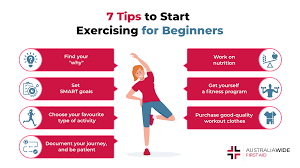Looking to transform your fitness journey? This guide takes you from beginner to pro with expert tips, workout routines, and nutrition advice for optimal physical fitness.
Achieving optimal physical fitness is not just about looking good—it’s about feeling strong, healthy, and energized. Whether you are a complete beginner or someone looking to take your fitness to the next level, this guide will provide you with the essential knowledge, strategies, and step-by-step plans to help you succeed. From workout routines to nutrition and recovery, we’ve got you covered.
Chapter 1: Understanding Physical Fitness
What is Physical Fitness?
Physical fitness refers to a state of health and well-being that enables an individual to perform daily activities efficiently and effectively. It consists of five key components:
- Cardiovascular Endurance – The ability of the heart and lungs to supply oxygen to the body.
- Muscular Strength – The capacity of muscles to exert force.
- Muscular Endurance – The ability of muscles to perform repeated contractions.
- Flexibility – The range of motion of joints.
- Body Composition – The ratio of fat to lean mass in the body.
Why is Physical Fitness Important?
- Reduces the risk of chronic diseases such as diabetes and heart disease.
- Enhances mental well-being by reducing stress and anxiety.
- Boosts energy levels and improves sleep quality.
- Promotes longevity and overall quality of life.
Chapter 2: Starting Your Fitness Journey
Setting SMART Goals
A successful fitness journey begins with setting SMART goals:
- Specific: Define your goal clearly (e.g., lose 10 pounds, run a 5K).
- Measurable: Track progress using metrics like weight or reps.
- Achievable: Set realistic goals based on your current fitness level.
- Relevant: Align your goals with your overall health and lifestyle.
- Time-bound: Set a deadline to stay motivated.
Choosing the Right Workout Routine
Beginners should focus on a balanced mix of:
- Cardio (3-5 times per week): Running, cycling, swimming.
- Strength Training (2-3 times per week): Bodyweight exercises, resistance bands, weightlifting.
- Flexibility & Mobility (Daily): Yoga, stretching, foam rolling.

Chapter 3: Workout Plans for Different Levels
Beginner Workout Plan (Weeks 1-4)
- Monday: Full-body strength training (squats, push-ups, rows)
- Wednesday: 30-minute brisk walking or jogging
- Friday: Core & flexibility exercises (planks, yoga, stretching)
- Sunday: Rest or light activity (e.g., walking)
Intermediate Workout Plan (Weeks 5-8)
- Monday: Upper body strength training (bench press, pull-ups)
- Tuesday: 40-minute cardio (cycling, swimming)
- Thursday: Lower body strength training (deadlifts, lunges)
- Saturday: HIIT (High-Intensity Interval Training)
Advanced Workout Plan (Weeks 9+)
- Monday: Strength training with progressive overload
- Wednesday: Sprint intervals and endurance cardio
- Friday: Mobility work and active recovery
- Saturday: Functional training (kettlebells, plyometrics)
Chapter 4: Nutrition for Optimal Fitness
Macronutrients Explained
- Proteins (Chicken, fish, eggs, tofu) – Essential for muscle repair and growth.
- Carbohydrates (Brown rice, quinoa, oats) – Provides energy for workouts.
- Fats (Avocados, nuts, olive oil) – Supports hormone function and recovery.
Hydration and Supplements
- Drink at least 2-3 liters of water daily.
- Consider protein powder for muscle recovery.
- Creatine can enhance strength and performance.
Chapter 5: Recovery and Injury Prevention
The Importance of Recovery
Recovery is just as important as working out. Proper recovery includes:
- Rest Days: Essential for muscle growth.
- Stretching & Foam Rolling: Prevents stiffness and enhances mobility.
- Quality Sleep: 7-9 hours per night aids in muscle repair.
Common Injuries and How to Prevent Them
- Runner’s Knee: Strengthen quads and stretch hip flexors.
- Lower Back Pain: Strengthen core muscles.
- Shoulder Strain: Use proper form in weightlifting.
Chapter 6: Staying Motivated and Tracking Progress
How to Stay Consistent
- Find a Workout Buddy: Increases accountability.
- Track Your Progress: Use a fitness journal or apps like MyFitnessPal.
- Reward Yourself: Celebrate small milestones.
Overcoming Plateaus
- Change your routine every 4-6 weeks.
- Increase intensity or resistance gradually.
- Incorporate new exercises to challenge different muscle groups.
Optimal physical fitness is a lifelong journey that requires dedication, smart goal setting, and the right combination of workouts, nutrition, and recovery. Whether you’re just starting or striving to reach an advanced level, following this structured approach will help you achieve and maintain your fitness goals.
Frequently Asked Questions (FAQ)
1. How long does it take to see fitness results?
It varies, but most people see noticeable changes within 4-8 weeks with consistent training and nutrition.
2. Can I build muscle and lose fat at the same time?
Yes, through a combination of strength training, proper nutrition, and maintaining a slight calorie deficit.
3. How many times a week should I work out?
For beginners, 3-4 times a week is ideal. Intermediate and advanced individuals can train 5-6 times per week.
4. Do I need supplements to get fit?
No, but supplements like protein powder and creatine can support your progress if used correctly.
5. What is the best type of cardio for fat loss?
Both steady-state cardio (e.g., jogging) and HIIT (High-Intensity Interval Training) are effective for fat loss, but HIIT burns more calories in a shorter time.
By following this guide, you’ll have the knowledge and tools needed to transform your fitness journey from beginner to pro. Stay consistent, stay motivated, and most importantly, enjoy the process!